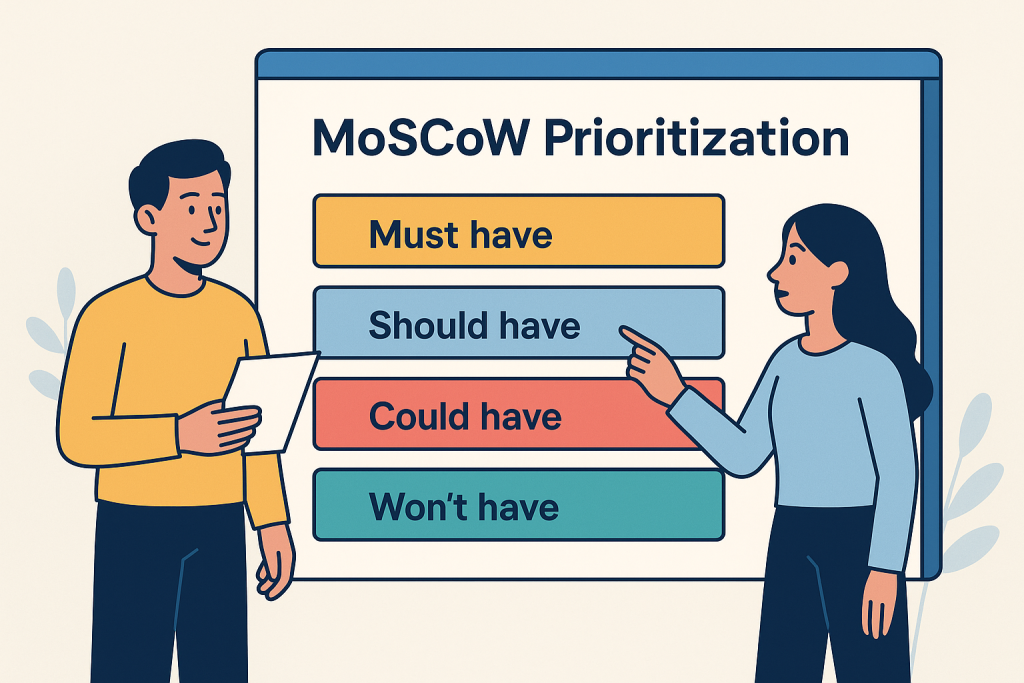What is MoSCoW Prioritization?
MoSCoW prioritization is a widely used framework for organizing project requirements based on their importance. The term MoSCoW stands for four priority levels: Must-have, Should-have, Could-have, and Won’t-have (or not prioritized at this time). In some cases, organizations interpret the “W” as “Wish” to denote desirable but non-critical items.
This technique helps teams allocate resources efficiently, focusing on high-impact tasks to achieve project goals effectively.
What is the History of the MoSCoW Method?
The MoSCoW framework was pioneered by Dai Clegg, a software development specialist at Oracle. He created it to streamline task prioritization for his team during product development cycles. You can find a detailed account of using MoSCoW prioritization in the. Its versatility has led to its adoption beyond software, in areas like event planning, business operations, and product management.
How Does MoSCoW Prioritization Work?
To apply MoSCoW prioritization, teams must complete several preparatory steps. First, project leaders and stakeholders need to align on goals and criteria for prioritization. Next, everyone involved should agree on the initiatives to focus on.
It’s also important to define a method for handling prioritization conflicts early on. Establishing this process upfront can prevent delays caused by disagreements.
Lastly, the team should decide how much of the project’s resources will be dedicated to each priority category.
Once these steps are in place, the team can start assigning initiatives to the appropriate MoSCoW categories. Let’s explore these categories in detail.
Start prioritizing your roadmap
MoSCoW Prioritization Categories
1. Must-have initiatives
This category includes initiatives that are absolutely essential for the project’s success. These are non-negotiable requirements without which the product or deliverable would fail. For instance, in an e-commerce platform, a must-have might be a secure checkout system.
Must-haves are mandatory tasks. To determine if an initiative belongs here, consider this question:
If the project cannot function or meet its core purpose without this initiative, it’s likely a must-have.
2. Should-have initiatives
Should-have initiatives are important but not critical to the project’s core functionality. They enhance the deliverable significantly but can be deferred to a later phase if needed. The project remains viable without them, though their absence may reduce value.
For example, adding advanced search filters to a website might be a should-have initiative. These can be planned for future iterations without affecting the current release.
3. Could-have initiatives
Could-have initiatives are often referred to as nice-to-haves. They are desirable features or enhancements that have a minimal impact on the project’s success if excluded. Compared to should-haves, their absence is less noticeable.
These initiatives are typically the first to be deferred if must-have or should-have tasks require more resources than anticipated.
4. Will not have (this time)
The won’t-have category includes initiatives that are explicitly excluded from the current project scope. This designation clarifies what will not be delivered, helping to manage expectations and avoid scope creep.
Initiatives in this category are not prioritized for the current timeframe. Some may be considered for future projects, while others may never be pursued. Teams may create subcategories to distinguish between these possibilities.
How Can Development Teams Use MoSCoW?
While Dai Clegg initially developed MoSCoW to manage time constraints, the framework is also effective for other limitations. For example:
Prioritize based on budgetary constraints.
If a team faces a limited budget, they can use MoSCoW to identify must-have and should-have initiatives, then allocate funds to complete as many high-priority tasks as possible within financial limits.
Prioritize based on the team’s skillsets.
When a team lacks the expertise to implement certain features, MoSCoW helps prioritize tasks they can realistically accomplish, postponing others until the necessary skills are acquired.
Prioritize based on competing needs at the company.
When multiple projects compete for attention, MoSCoW enables teams to focus on must-have elements for the current deliverable, moving less urgent tasks to the backlog.
What Are the Drawbacks of MoSCoW Prioritization?
While MoSCoW is widely used, it has some limitations that teams should be aware of. Here are a few examples.
1. An inconsistent scoring process can lead to tasks placed in the wrong categories.
MoSCoW does not provide a standardized way to evaluate initiatives, which can lead to subjective categorizations. Teams need to implement their own evaluation criteria to ensure consistency.
Pro tip: One effective approach is weighted scoring, where initiatives are assessed based on predefined factors like cost, benefit, and strategic alignment.
2. Not including all relevant stakeholders can lead to items placed in the wrong categories.
Comprehensive input is crucial for accurate prioritization. Without perspectives from key groups, such as marketing or customer support, teams may misjudge an initiative’s importance.
For example, a customer support team might highlight the value of a feature that the development team initially overlooked.
Failing to involve all stakeholders can result in poor prioritization decisions.
3. Team bias for (or against) initiatives can undermine MoSCoW’s effectiveness.
Without an objective evaluation system, team members’ personal preferences can influence decisions, leading to skewed priorities.
A common issue is assuming MoSCoW itself is an objective tool. Teams may quickly categorize an initiative as a “should-have” without thorough analysis.
To counter this, teams need a clear, consistent framework to evaluate all initiatives and minimize bias.
When Do You Use the MoSCoW Method for Prioritization?
MoSCoW prioritization shines when teams need to involve diverse stakeholders from across the organization. Including voices from different departments ensures a well-rounded perspective on priorities.
Additionally, MoSCoW helps teams allocate effort across priority categories, enabling a balanced mix of essential and value-adding initiatives in each project phase.
What Are Best Practices for Using MoSCoW Prioritization?
To get the most out of MoSCoW prioritization, consider these steps to enhance your process.
1. Choose an objective ranking or scoring system.
MoSCoW organizes initiatives into categories but doesn’t guide which initiatives belong where. Teams need a separate evaluation method.
Options include:
- Weighted scoring
- Value vs. complexity
- Kano model
- Buy-a-feature
- Opportunity scoring
2. Seek input from all key stakeholders.
Accurate categorization requires diverse perspectives. At the start, identify stakeholders who can offer valuable insights, such as marketing, operations, or senior leadership.
Including these groups helps uncover opportunities or risks the core team might miss, ensuring better-informed decisions.
3. Share your MoSCoW process across your organization.
MoSCoW provides a clear way to demonstrate how your team prioritizes initiatives, fostering transparency.
Sharing the process helps build organization-wide support or at least clarifies the reasoning behind your choices.
This transparency sets expectations and ensures other departments understand your prioritization logic. If stakeholders disagree with a decision, they’ll need to provide evidence to challenge it.


